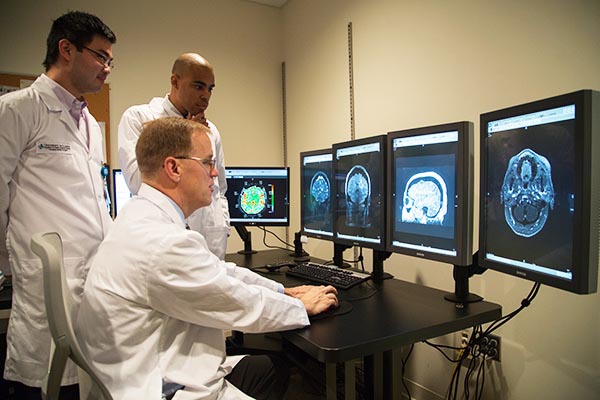Magnetic resonance imaging harnesses the power of magnets and radio waves to see inside the human body. Found in hospitals and doctors offices worldwide — in 2013, there were an average 14 MRI machines per million people in the 35 developed countries that comprise the Organization for Economic Cooperation and Development — MRI machines generally have a field strength of about 1.5 teslas (that’s the same as a junkyard magnet). Today's field trip takes us to the University of Illinois Chicago (UIC) Medical Center to see a whopping 9.4-tesla MRI.

Reviewing images from the 9.4-tesla human MRI.
photo by: Hoss Fatemi
Unveiled in 2003, this remarkable research tool measures nearly 3 meters tall and weighs as much as a humpback whale. The tunnel-like center of the magnet (known as the bore) is big enough to fit a linebacker, but researchers are particularly interested in using the magnet to see inside the human brain.
While commercial MRIs detect hydrogen (or water) in the body, researchers require ultra-powerful magnetic fields to see sodium ions, a metabolic marker of healthy cells and tissues. A lower concentration of sodium indicates higher cell density — or more healthy cell-to-cell interactions — while a higher sodium concentration shows a loss of cells.
Scientists recently imaged sodium using this massive MRI to measure changes in brain cell density as we age.
"We've known for some time that the human brain shrinks with normal aging," explains Dr. Keith Thulborn, director of MRI research at UIC College of Medicine and lead researcher on this work. "But this research shows that the shrinkage is not due to a loss of brain cells. Measuring sodium concentration, we can see that the number of brain cells and the density of those cells stay constant regardless of age."
And while that finding is already exciting, Thulborn believes it could have even bigger implications on human health in the future.
"Measuring sodium concentration to see these cell density changes could be the key to early identification of neurodegenerative diseases like Alzheimer's, which may show effects on the cellular level decades before clinical symptoms," he said.
An even more powerful 10.5-tesla instrument is located at the University of Minnesota (research on humans is expected to begin in 2017), and an 11.7-tesla effort is underway through a collaboration between France and Germany. The strongest MRI for small animals — 21.1 teslas — is located at the National MagLab's headquarters in Tallahassee, Florida.
By Kristin Roberts